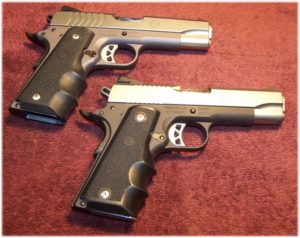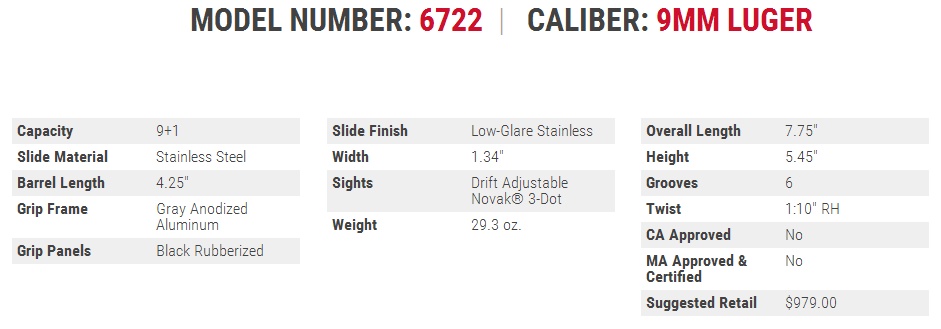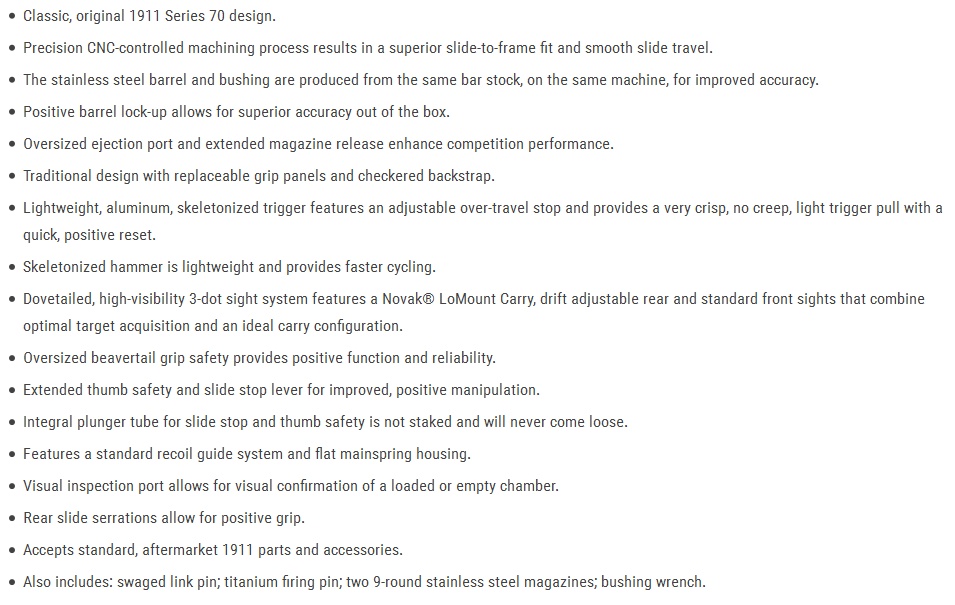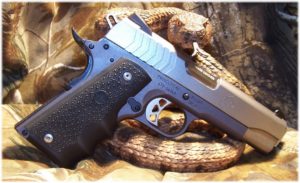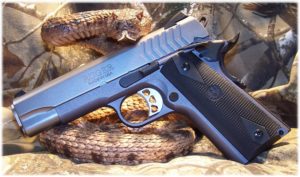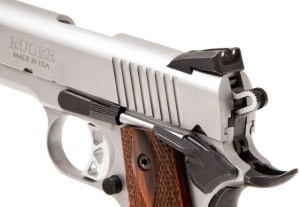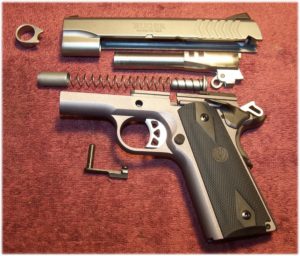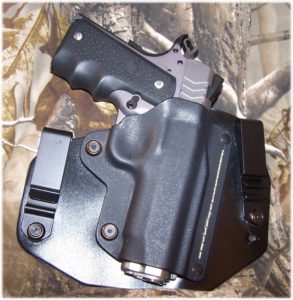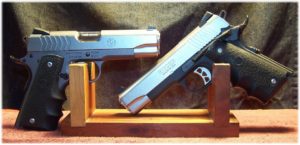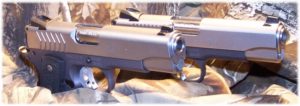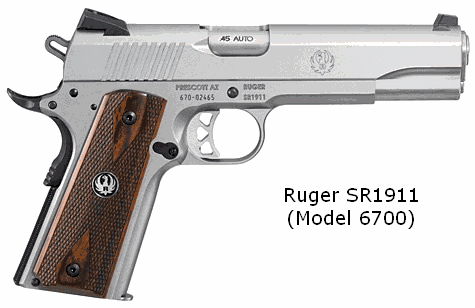 In 2011, in the year of the 100th anniversary of the M1811, Ruger presented a series of pistols that aligned with the John Moses Browning 1911 platform. Since 2011, Ruger has brought us three versions of their 1911 that typify the most popular original 1911 pistols for the civilian market, but with modern refinements; the SR1911 (a “Government” model), the SR1911CMD (a “Combat Commander” model), and the SR1911CMD-A (a Lightweight Commander” model). The original 1911 design was chambered for 9mm but soon was made in .45 ACP due to military requirements; the military version of the 1911 came to be known as the M1911. On July 1, 2016, Ruger put forth a SR1911 that is chambered in the original 9mm Luger cartridge; a lightweight SR1911 (Model 6722).
In 2011, in the year of the 100th anniversary of the M1811, Ruger presented a series of pistols that aligned with the John Moses Browning 1911 platform. Since 2011, Ruger has brought us three versions of their 1911 that typify the most popular original 1911 pistols for the civilian market, but with modern refinements; the SR1911 (a “Government” model), the SR1911CMD (a “Combat Commander” model), and the SR1911CMD-A (a Lightweight Commander” model). The original 1911 design was chambered for 9mm but soon was made in .45 ACP due to military requirements; the military version of the 1911 came to be known as the M1911. On July 1, 2016, Ruger put forth a SR1911 that is chambered in the original 9mm Luger cartridge; a lightweight SR1911 (Model 6722).
I have noticed that Ruger no longer refers to their “Combat Commander” and “Lightweight Commander” pistol by that designation. All models of the SR1911 is simply referred to by the model number; Model 6700, Model 6702, Model 6711, and model 6722. The Model 6722 is the focus of this review; the lightweight, 9mm SR1911.
Some reviews of the Model 6722 have already been published by established gun writers with an “in” to new Ruger products. I am just another Ruger customer and my opinions of firearms are based on what came off the shelf, and which would be available to us common folk.
Ever since the Model 6722 was introduced, I knew that I wanted one. Not that I am a fan of the 9mm cartridge; but that could change with the right pistol and the right defensive cartridge, but I am a fan of the 1911 platform and usually carry and shoot it over all other platforms.
While the 9mm Model 6722 is similar in many ways to its predecessors, there are many differences that warrant presentation. I could, like other writers, just mention the differences, but I feel that is cheating. You will read the “Full Monty” about the pistol and not just some pick-and-choose points for the purpose of a brief article. I have no deadline to meet and I sure do not get paid for doing this – except for the satisfaction of knowing that I brought my best to the table for you – the reader.
I will say, right up front, that Ruger has stepped up the 1911 game with the Model 6722 and you are about to read why that is.
THE BASICS:
The following basic features of the Model 6722pistol are presented in the images that follow.
What’s In the Box?
I was somewhat disappointed that Ruger did not include a pistol rug as they have with other models that I have purchased; it was a nice touch and a good way to protect the firearm.
The Model 6722 comes wrapped in a plastic bag within a Ruger cardboard box. A foam insert protects the sights. Various items of paperwork accompany the pistol. The paperwork includes; Instruction Manual, A lubrication guide, a Ruger decal, and sundry other documents to include instruction for registration of the firearm (with Ruger), a Ruger Bearcat upgrade notice and other marketing material.
Additionally, you get a cable lock, two magazines, and a chamber flag. A test-fired cartridge case was not provided, although the pistol had been test-fired by the factory.
I do advise you to read the Instruction Manual, although you may be well-versed in the 1911 platform; there are many warnings, cautions, and notes that you need to be aware of with the Ruger SR1911 series of pistols.
CLASSIC STYLING:
Like other SR1911 pistols, the Model 6722 follows the “Series 70” pistols that Colt manufactured for the civilian market. The original 1911 Series “70” design provides for easy take-down and re-assembly. The Model 6722 has the same slim traditional design as the M1911, but through extensive research as to what those who like the 1911 platform are now expecting in a newer version of the original, Ruger has added those expected features.
BARREL AND SLIDE:
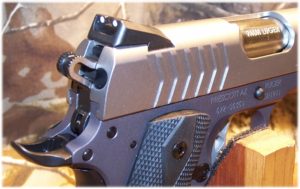 Precision CNC-controlled machining process results in a superior slide-to-frame fit and smooth slide travel. The 4.25-inch stainless steel barrel and mated bushing are produced from the same bar stock, on the same machine, for improved accuracy.
Precision CNC-controlled machining process results in a superior slide-to-frame fit and smooth slide travel. The 4.25-inch stainless steel barrel and mated bushing are produced from the same bar stock, on the same machine, for improved accuracy.
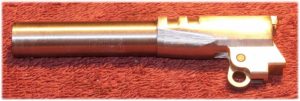 The barrel is quite thick with a 9mm bore. It should be noted that the unloaded weight of the 9mm version of the SR1911CMD-A is the same as the .45 ACP version of the same pistol. This translates to less felt recoil and muzzle rise with the 9mm version of the SR1911CMD-A.
The barrel is quite thick with a 9mm bore. It should be noted that the unloaded weight of the 9mm version of the SR1911CMD-A is the same as the .45 ACP version of the same pistol. This translates to less felt recoil and muzzle rise with the 9mm version of the SR1911CMD-A.
The chamber of the barrel incorporates a “Peek See” slot. The slot provides a visual means in determining if a cartridge is chambered.
The Model 6722 utilizes the “Swing Link” design fostered by John Browning (see, INTERNALS).
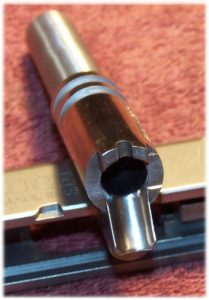 Unlike the Model 6711 (the .45 ACP version), which uses a titanium insert in the frame as a feed ramp, the barrel in the Model 6722 utilizes a fully-supported integral ramp feeding system. Given the issues with chambering small diameter cartridges other than “ball type” ammunition, this was a good move on Ruger’s part.
Unlike the Model 6711 (the .45 ACP version), which uses a titanium insert in the frame as a feed ramp, the barrel in the Model 6722 utilizes a fully-supported integral ramp feeding system. Given the issues with chambering small diameter cartridges other than “ball type” ammunition, this was a good move on Ruger’s part.
Due to a lighter recoil spring (#16 according to Ruger) than what is found on the Model 6700, Model 6702, and Model 6711 (the 45ACP versions of the SR1911), the slide is easy to very easy to move rearward by hand. That should make folks with hand strength issues very happy. As a side note, if you are planning on shooting +P ammunition, you may want to consider installing a #18 recoil spring (or even a #20 spring, if needed). One beauty of the 1911 platform; we can quickly change recoil springs to accommodate different loadings, which tailors the gun to what ammunition we shoot.
The slide is forged stainless steel. While most parts are manufactured in-house, some are manufactured elsewhere, but all are manufactured within the U.S.
The slide incorporates a different pattern of rear serrations than is found on other SR1911 pistols. Rather than being simple slant or vertical serrations, the rear serrations are “Chevron” in shape. While some might like the “Chevron” design, while some 1911 purists will rail against it. The rear serrations provide a good gripping surface for manually operating the slide. True to original 1911 slide, no front serrations are provided.
All slide surfaces are nicely angled to provide a “snag-free” environment for the hand.
The ejection port is lowered and relieved to allow positive ejection of an expended cartridge. Extraction of cartridges is positive.
TRIGGER AND HAMMER:
The lightweight, aluminum, skeletonized trigger features an adjustable over-travel stop and provides a very crisp, no creep, light trigger pull with a quick, positive reset. Some have claimed that the trigger fit is too loose. I have no problem with the fit and function of the trigger. The MODEL 6722 is not, after all, a custom ED Brown. The trigger pull on my particular MODEL 6722 is an easy-to-pull 4.5-pounds and my finger has told me that it likes the trigger. The edge of the trigger indexes into the first joint of my shooting finger (where I prefer one to index), does not “sting” my trigger finger (as have some triggers on polymer wonder guns), and serves the same purpose as does those “hand-fitted” triggers. I can live with that.
The skeletonized hammer is lightweight and provides faster cycling. Pulling the hammer back to the cocked position reveals a substantial hammer spring. The hammer is nicely roiled to provide a good purchase when cocking and de-cocking the pistol.
SIGHTING SYSTEM:
that combines optimal target acquisition in an ideal carry configuration. Some have complained that the sights are too small, but I have no issue with them.
The rear sight is drift-adjustable and is held into the slot with a hex-head screw. On my particular pistol, there was no need for windage adjustments because the sights were spot on. In bright sunlight, and with my old eyes, the sights were easy to pick up. However, in my usual fashion, I dropped a dot of fluorescent or “glow” red in the front dot well for a bit of contrast.
FRAME AND GRIP:
The aluminum alloy frame received an excellent matte gray finish treatment that is close to “Charcoal gray” depending on the ambient light. I can honestly say that the gray frame looks much better in person that what is depicted in images. The frame’s finish appears lightly brushed like the slide and most appealing.
When the pistol is cocked, there is a very light side-to-side movement between the frame and the slide, which causes a slight, audible rattle with the pistol cocked. None of my other SR1911s exhibit this much play. I am hoping that this is not a problem. When the pistol is in battery with the hammer down, there is no play. Only use will tell if it is an issue.
I contacted Ruger about the slide-to-frame fit and they assured me that a little looseness was normal.
While there have been some plunger tube failures with 1911 pistols, the plunger tube on all SR1911 models is an integral part of the frame and is unlike other 1911’s where the plunger tube is staked to the frame. Although I have never had a plunger tube fail, with the Model 6722 that is one issue I don’t have to even concern myself with.
Just below the excellent beaver-tail grip safety is the nicely-checkered metal hammer spring housing that also contrasts nicely with the frame, just like found on the .45 versions of the SR1911.
The grip panels are slim and made of a hard rubber composite embossed with the Ruger logo. They look great against the frame’s matte gray finish, and they do feel good, but they feel too slim in my hand. I changed the panels, as with any 1911 that I might carry, with the Hogue Wraparound Rubber Grip with Finger Grooves. However, shooters with small hands may welcome the slim grip panels.
It was when changing the grip panels that I found an issue with the pistol. The left-bottom grip bushing and grip bushing screw was stripped out at the factory. Since I did not have any grips crew bushings on hand, I cannibalized another 1911 for a bushing. A little dab of Blue Thread Locker and I was back in business. Note that his issue was not something that QA/QC might have caught, but I do blame the assembler for letting this slide (no pun intended).
I contacted Ruger about the issue and they are sending me replacement grip screw bushings. UPDATE: I received from Ruger a complete set of standard and thin grip screw bushings a week after I had spoken with Ruger. Great customer service, in my opinion!
Unlike the original 1911 pistol, the Ruger SR1911 series of pistols uses black hex-head screws to secure the grip panels rather than slotted-head screws. As with the grip panels, the new Hogue grip is fastened with Hogue stainless steel grip screws to augment the looks of the grip and fall in line with the pistol’s brushed stainless steel slide.
SAFETIES:
The Ruger SR1911 series of pistols remains true to the original 1911 safeties of the “70” series with a slight twist. The over-sized beaver-tail grip safety provides positive function and reliability. The extended thumb safety and slide stop lever provide for improved, positive manipulation. Although the slide stop, thumb safety and magazine release button are extended, they are not obtrusive to the hand. The beaver-tail grip safety has a minute amount of side play but is well-fitted. The beaver-tail safety functions as it should and the “memory bump” ensures positive operation every time that it is pressed.
.
In keeping with the 1911 tradition, the thumb safety is mounted on the left side only.
The thumb safety is stiff, but positive, when new. Some might consider it too stiff, but I would rather have my safety stiff than not. I ride the thumb safety when I shoot, which allows me to get my hand as high on the back strap as possible. I would not appreciate the thumb safety going “on safe” during a string of fire. As a side note, I do like ambidextrous safeties because I try to run a 1911 as much weak hand (left) as I can and an ambidextrous thumb safety is a great feature to have. With that said, I am not going to replace the thumb safety. I can also run a 1911 left-handed and know a few tricks about running the safety weak handed.
An internal safety feature, not found on the original 1911 is the use of a stiff firing pin spring and a lightweight titanium firing pin. This arrangement staved off the need for a (undesired by most) firing pin block since the pistol can be dropped and the firing pin will not reach the primer of a chambered round.
MAGAZINES:
Two stainless-steel Ruger 9-round magazines ship with the Model 6722 pistol. The magazines; however, are extremely stiff and loading 9 rounds into each magazine took the assistance of an UpLula Loader (see, RESOURCES). However, any aftermarket magazine will work just fine in the Ruger for carry. Additionally, I would have a couple of 10-round magazines as spares.
With the provided Ruger magazines, I could not lock in the magazines with a 9-rounds loaded and the slide in battery. What this means is that I could not chamber one and then top off the magazine. That also means that if I were to carry the Model 6722, “combat reloads” would not be possible unless I use magazines that allow me to do that.
With a Metalform (see, RESOURCES) 9-round flush fit magazine; however, I had no problem seating a full magazine with the slide in battery.
I have contacted Ruger and they are currently undergoing testing for a different magazine provider. In the meantime, I will be ordering more Metalform magazines for the Ruger and my Rock Island Armory 9mm 1911.
With that said, the magazines provided by Ruger with the pistol performed flawlessly at the range (see, RANGE TIME).
INTERNALS:
Internally, the MODEL 6722 is well finished to include the feed ramp.
The Model 6722 uses the Browning “swinging Link” design. The barrel has multiple lugs atop to engage recesses milled into the slide. The lock-up is very tight, with little if any discernible play between the slide, barrel, and frame. Reliability is paramount in a fighting pistol, and the 1911 design has excellent reliability. It is also one of the most durable designs and it is just extremely hard to wear a short-recoil tilting breech 1911 out by shooting it.
Although I would not consider it a safety, which is something that I consider as an item that prevents the pistol from going boom when you don’t want it to, a visual inspection port on top of the chamber allows for visual confirmation that chamber is loaded. This negates the need for performing a “press check” that I have never felt the need to do; if the slide is forward, I consider it loaded until I prove otherwise.
And, the Ruger MODEL 6722 does not have a magazine disconnect safety.
FIELD STRIPPING AND ASSEMBLY:
Disassembly and assembly follow the same procedures as any “True-to-Form” 1911. There are no special tools required and no full-length guide rod to contend with. In fact, the Model 6722 can be easily disassemble and assembled while blindfolded once you get to know the process, as long as somebody does not walk away with the parts. Although Ruger does supply a barrel bushing wrench, I have yet to unpack it.
Ruger provides Lubrication Instructions with the pistol.
VISUAL IMPACT:
The MODEL 6722 is a very cleanly finished pistol. There are no front serrations or fancy sculpturing. The rear “Chevron” slide serrations are nicely blended into the pistol while providing a good purchase for the hand. All edges are nicely finished.
The front and rear sight, extended magazine release button, slide lock, hammer, thumb safety, beaver-tail grip safety, extractor button, and checkered metal mainspring housing and all pins are black and contrast nicely with the stainless slide and gray finish of the frame.
Ruger did a good job in laser-etching the slide and frame with RUGER MADE IN THE USA etched on the left side of the frame and the Ruger “Eagle” etched on the right side of the frame. Note that “READ INSTRUCTION MANUAL BEFORE USING FIREARM” is on the underside of the frame, but it is barely discernible due to the finish of the pistol.
The MODEL 6722 uses the traditional straight barrel and bushing arrangement and utilizes a standard guide rod and guide rod bushing, which keeps the front end looking clean and mean. I have no intention of changing the guide rod system to a full-length guide rod, at least at this time.
Although the metal mainspring housing is checkered, the front strap is clean of serrations. The Hogue Wraparound grip covers this area and provides my shooting hand with a little more grip area to hold onto; I like a slightly over-size grip area.
The long, aluminum skeletonized trigger is nicely done and has a flat, serrated surface that I like. The edge of the trigger indexes right into the first joint of my shooting finger, which is where I prefer a trigger to be on full-sized handguns. The trigger also incorporates an over-travel stop screw, but blends well with the trigger. The trigger area is also relieved for the trigger finger of either hand.
From the right side, the lowered and flared ejection port provides a nice escape for expended shell casings and extracting and expending shell casings is something that the MODEL 6722 does well as Ruger has beefed up the internal extractor for positive extraction.
Like the SR1911, the bead-blasted brushed finishes of the pistol makes the MODEL 6722 look classy without looking flashy.
Overall, the MODEL 6722 is a clean looking, visually-appealing 1911-based pistol. It has features that would be considered custom in the past but are now considered standard fare. The quality is built in and there should be no doubt about that.
Currently, my Ruger MODEL 6722 is outfitted with a Hogue Wraparound Rubber Grips with Finger Grooves (see, RESOURCES) and mounted with Hogue Hex head Screws Stainless Steel grip screws (see, RESOURCES) that add contrast to the stainless steel finish slide of the pistol and with the charcoal gray finish of the frame. I prefer the Hogue rubber wraparound grips to many others when it comes to a handgun that I may have to fight with as my fingers fall right into the finger groves, they add to the girth of the grip area, and (I feel) that I have much more control of the pistol.
HOW IT CARRIES:
I like the grip area to be pulled tightly into my side regardless if I am carrying IWB or OWB and, so far, a modified SHTF Gear ACE-1 Gen 2 Holster (Now, Black Arch Holsters) that has substantial Kydex to protect the 4.25-inch barreled Ruger MODEL 6722has met my expectations for IWB carry. The holster is modified in that the sweat guard has been removed and I have added a little more forward cant to the holster to keep the butt of the pistol forward, which helps to blend the full-size grip of the MODEL 6722 (or any pistol for that matter) into my side.
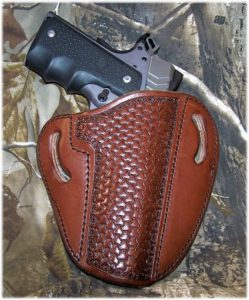
Leather Creek Holster for OWB Carry. Note That Holster is for a Government Model 1911 and Affords Full protection for Government and Commander-size 1911 Pistols
For OWB carry, a fine holster from Leather Creek Holsters fits the bill (actually made for a full-size 1911), and it was made locally by a local master leather smith. Of course, the holster choice for the 1911-based pistol is wide and varied and is a personal choice, but it must be a good choice.
To accommodate the weight of the MODEL 6722 pistol and also two spare 10-round magazines of 124-grain hollow point ammunition, I also wear suspenders. This is, of course, a personal choice. The pistol, when loaded, is very light as compared to the all stainless steel models and that translates into a pistol that won;t take you pants to the ground unless you are extremely careless or could care less.
To carry the MODEL 6722 IWB also means that I wear a t-shirt to prevent the butt of the pistol from rubbing against bare skin and from getting moisture during the hot summer months of the South from getting to the pistol (regardless of what I am carrying at the time). Some folks welcome the sweat shield on most IWB holsters, as it does what it means. However, and especially with a 1911-based pistol, I don’t want any possible interference with the operation of the thumb safety or my thumb getting to it during the draw stroke. I normally position the thumb on the shooting hand above the thumb safety during the actual draw stroke. When the gun is in the proper firing position, and I am ready to fire, the thumb safety is pushed off-safe. When I am holstering the pistol, the thumb of my shooting hand is below the thumb safety and applies pressure to it during holstering until the pistol is completely holstered. A sweat shield would interfere with this operation.
RANGE TIME:
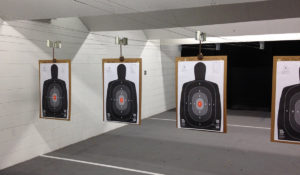 The Model 6722 pistol is a joy to shoot. In the early days, I used to shoot a 1911 with the shooting hand thumb under the thumb safety lever, and I still find myself doing that at times. With the advent of extended thumb safeties, I find myself more and more shooting with the thumb of the shooting hand over top of the thumb safety, which enables me to get as high a grip as possible on the pistol, which translates to more recoil being pushed into the hand and a reduction in muzzle flip.
The Model 6722 pistol is a joy to shoot. In the early days, I used to shoot a 1911 with the shooting hand thumb under the thumb safety lever, and I still find myself doing that at times. With the advent of extended thumb safeties, I find myself more and more shooting with the thumb of the shooting hand over top of the thumb safety, which enables me to get as high a grip as possible on the pistol, which translates to more recoil being pushed into the hand and a reduction in muzzle flip.
As with all Ruger SR1911 pistols, I find myself aiming at what I want to hit with the barrel of the pistol and with the sights slightly above the intended point of impact. This is what I call a “covered” sight position and it is my favorite. I have never cared for a 6 o’clock hold that much.
The trigger is very nice; albeit, slightly gritty when first pulled. After dry-firing prior to the range session, I could feel the trigger smoothing out. There is a slight amount of take-up. After resistance is felt, and after about 4.5 pounds of pull is felt, the trigger releases softly but crisply (if that makes sense), the hammer falls, and magical things happen; the bullet leaves the barrel, extraction is positive, and the empty casing is ejected well clear of the pistol.
I had 50-rounds of Aguilla 124-grain FMJ (1115 fps) and 50 rounds of locally-manufactured 124-grain FMJ (1150 fps) to start the initial break-in process. As usual, I was more interested in function than for accuracy the first time out; however, if the pistol proved to be relatively accurate with this ammunition, I then consider accuracy a bonus.
Unlike a lot of professional firearm reviewers who have use their favorite ammunition to run through the firearms that they evaluate, I “run what I brung” and that is usually just what I have on hand. I am not usually that critical when I try out a firearm for the first time. If I am considering a firearm for self-defense, the game plan changes and I begin evaluating various defensive loads in the firearm and then determine what works best for that particular firearm.
I started out the session using the magazines that were provided by Ruger for this pistol. Despite having to use a UplUla magazine loader, the magazines functioned with no issues. Switching over to Metalform and the Wilson Combat #500-9 1911 Elite Tactical Magazine yielded the same results. In short, the Ruger SR1911 Model 6722 ran without issues of any kind.
Three of my shooting companions took turns shooting the pistol and was pleasantly surprised at how well it performed; the trigger pull was excellent, the recoil was soft, and the sights were right on – in their opinion, and I happen to agree with them. In fact, one shooter said that he was going to get one of his own.
DON’T TAKE MY WORD FOR IT:
In this area, I post some links to other reviews of this pistol. While I can’t post all of the reviews, I have selected some that will serve as a starting point in gathering information about the Ruger Model 6722. Note that in this point in the pistol’s life-cycle, there are not that many reviews available.
- Ruger Lightweight 9x19mm SR1911 Semi-Automatic Pistol: http://www.gunblast.com/Ruger-SR1911CMD-9A.htm
- Ruger’s New 9mm SR1911 Lightweight Commander: https://www.gunsamerica.com/blog/rugers-new-lightweight-commander-9mm/
- Ruger Adds 9mm to Ruger SR1911 Pistol Line: http://www.ammoland.com/2016/07/ruger-sr1911-lightweight-commander-pistol-9mm/#ixzz4EIk1TXTR
IN CLOSING:
I was really excited about receiving the Model 6722 and my excitement after examining and shooting the pistol has not waned. In my opinion, Ruger has stepped up its game with the advent of the Model 6722.
The Model 6722 should appeal to new shooters and those already experienced 1911 platform operators, unless they are adamantly against shooting a 1911-based pistol in a cartridge other than with the .45ACP cartridge.
In my opinion, the lightweight Model 6722 exhibits nearly the same felt recoil with 124-grain ammunition as a full-size “Government” model 1911 when firing 185-grain ammunition. That means that I can get the same “feeling” of my EDC while shooting a less expensive cartridge like the 9mm.
While some might shun the 1911 platform, the 1911 platform of pistol, is to me, one of the safest pistols to carry. {Passive safety controls, like the grip and thumb safety, place the safety responsibility on the shoulders of the operator. The 1911 platform of pistol can be carried in all three conditions safely. However, those in California and Maryland will miss out on the joy since the Model 6722 is not approved for those states.
The Ruger Model 6722 is a fine example of the 1911 platform and is chambered in a caliber, which through modern ammunition design technology and better ballistics, is acceptable for plinking, sport shooting competition, home defense, and personal defense.
The Model 6722 is a well-done big boy toy. Some ladies may also find it appealing and an easy shooter. The Ruger Model 6722 would also be a good introduction to the 1911 platform for younger shooters due to the light recoil. Mama, don’t let your babies grow up to be Glock boys! (My apologies to Willie Nelson!)
The Ruger SR1911 Model 6722, in my opinion, would be an excellent carry for those who like the 1911 platform but desire a lighter, easier shooting pistol that would still provide the security of self preservation that they desire.
RESOURCES:
- Ruger 1911, Model 6722, 9mm: http://ruger.com/products/sr1911/specSheets/6722.html
- Leather Creek Holsters: http://www.leathercreekholsters.com/home.html
- Black Arch Holsters: https://www.blackarchholsters.com/pages/iwb-holsters
- Hogue Wraparound Rubber Grips with Finger Grooves 1911 Government: http://www.midwayusa.com/product/563401/hogue-wraparound-rubber-grips-with-finger-grooves-1911-government
- Hogue Grip Screws Hex Head 1911 Package of 4: http://www.midwayusa.com/product/665071/hogue-grip-screws-hex-head-1911-package-of-4
- Metalform (magazines): http://www.metalform.us/
- Wilson Combat #500-9 1911 Elite Tactical Magazine: http://www.midwayusa.com/product/735241/wilson-combat-elite-tactical-magazine-etm-with-base-pad-1911-government-commander-9mm-luger-10-round-stainless-steel
- UpLula: http://www.maglula.com/product/uplula-9mm-to-45acp/
![]()


